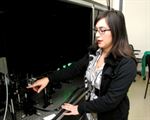
 When Andrea Rodarte began studying physics, she first wanted to look to the stars for answers. Instead, she’s finding them in nanoparticles.
When Andrea Rodarte began studying physics, she first wanted to look to the stars for answers. Instead, she’s finding them in nanoparticles.
“The people I know who went into astrophysics only get to do an experiment once or twice a year,” Rodarte said. “I can come to the lab and do an experiment every day. It’s much more hands-on and fun than I thought it’d be.”
Rodarte is a third-year UC Merced graduate student studying condensed matter physics with professors Linda Hirst and Sayantani Ghosh. She’s planning to graduate in a couple years.
This year, Rodarte published her first paper in Physical Review B, the American Physical Society’s journal devoted to condensed matter and materials physics. Last year, she was given the Margaret Burbidge Award for Best Experimental Research by a Graduate Student by the society’s California-Nevada section.
Rodarte’s path to physics began at Bullard High School in Fresno, where she developed an interest in science. Biology came easy, but physics was more challenging and more rewarding, and she decided to study it when she enrolled in college at California State University, Fresno.
After a few years, Rodarte decided to take a year off and spend time with her sister in North Carolina. On a tour of the NASCAR research and development division, she saw crews wrecking cars to see what could be done to make them safer.
It inspired her to return to Fresno State to finish her Bachelor of Science in physics.
After graduating, Rodarte took a job working as an electrical engineer for a Visalia-based electronics company. It was there she discovered her passion for conducting research and solving problems.
As she began exploring graduate school, she decided attending UC Merced was the best fit for her. She enrolled in 2009.
“I loved the idea of going to a new place and setting the bar for everyone else,” she said.
Rodarte studies nanoparticles. The paper she published in January shows that mixing liquid crystals and quantum dots allows researchers to more finely adjust what color of light is emitted through a film. The discovery could one day lead to more efficient solar cells or computer displays that show richer colors.
Rodarte is exploring the solar application. She’s going to stack several thin layers of the combination and connect it to a solar cell to see if the device can more efficiently convert sunlight to energy.
When she graduates, she plans to secure a postdoctoral fellowship before becoming a professor.
“It was a long, circuitous route,” Rodarte said, “but I couldn’t be happier being a graduate student and getting paid to do research and hang out in a lab.”






